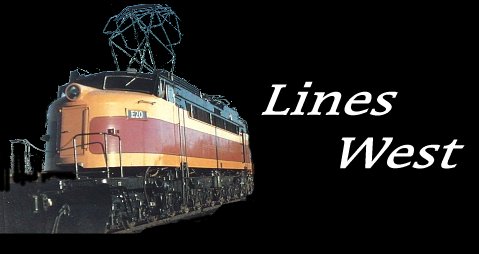
We
start off with a shot of Extra #156 east sitting at the east switch of
Newcomb siding,just east of Butte Montana.#156 is holding the main for
a meet with a westbound which arrives shortly.....
Photo by John Mosbarger©
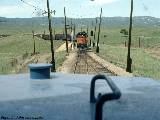 John
was fortunate enough to have been granted a cab ride this day.Here we see
Locotrol equipped SD40-2 #24 leading a westbound off of Pipestone Pass
and into the siding at Newcomb.
John
was fortunate enough to have been granted a cab ride this day.Here we see
Locotrol equipped SD40-2 #24 leading a westbound off of Pipestone Pass
and into the siding at Newcomb.
Photo by John Mosbarger.©
Milwaukee
shops built ribside caboose #992087 trails #24's train into the siding.
Photo by John Mosbarger ©
John
wasn't able to ride the eastbound over the pass,however that allowed him
to get some excellent shots of #156's train exiting Pipestone Pass Tunnel.In
these three photos we can watch as 4 SD40-2's drag their heavy train over
the Continental Divide.
Photo by John Mosbarger©
A
maelstrom of smoke and sound accompanies the four SD's as they head east
and onto the downgrade to Three Forks and beyond.
Photo by John Mosbarger. ©
Little
Joe E79 leads an eastbound train of 115 container loads at the crew change
point of Deer Lodge Montana on a frigid February day.The Milwaukee was
an innovator when it came to the transportation of COFC/TOFC traffic,hauling
more than 75% of this business out of the Port of Seattle,versus the 25%
for Burlington Northern and Union Pacific combined.
Photo © Michael Sol. 2/74
One
of the Milwaukee's elderly ES-2's shuffles cars in Deer Lodge yard. The
ES-2's were well liked by both crews and the mechanical department.With
the current always available in the catenary,they accellerated quickly,which
is a great benefit when it comes to kicking cars during switching operations.Mechanical
loved them because they were very simple and durable motors.It was rare
to find them in the shop.
Photo © Michael Sol 2/74
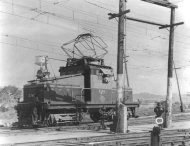 Here
the hogger leans out the window of his ES-2 to see signals from his switchmen.In
the days before radios,the engineer got all his instructions to move from
the hand signs of the men on the ground.
Here
the hogger leans out the window of his ES-2 to see signals from his switchmen.In
the days before radios,the engineer got all his instructions to move from
the hand signs of the men on the ground.
Location and photographer unknown.
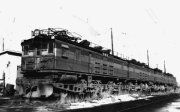 The GE Boxcabs were originally built as two unit
motors in the years 1915-1917.Later,as train sizes and weights grew,they
were combined into,first, three unit motors,and later four units.These
old motors,in sets of four,could still outpull six F7's over the Coast
and Rocky Mountain Divisions.
The GE Boxcabs were originally built as two unit
motors in the years 1915-1917.Later,as train sizes and weights grew,they
were combined into,first, three unit motors,and later four units.These
old motors,in sets of four,could still outpull six F7's over the Coast
and Rocky Mountain Divisions.
Location and photographer unknown.
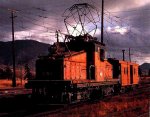 One
of Milwaukee's ES-2's broods it's future under stormy skies.
One
of Milwaukee's ES-2's broods it's future under stormy skies.
Photo by Dave Mewhinney,Deer Lodge
Montana 1954.
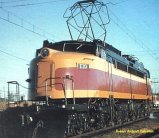 Here
is a shot of EP-4 class #E20 resplendant in Milwaukee's orange/maroon/black
passenger scheme.E20 and sister E21 were the only two Little Joes to be
converted for passenger service.The rear cab in each had it's controls
removed and a steam generator installed.Also,they were equipped with roller
bearings on all axles for cooler running at sustained high speeds.They
carried their low passenger numbers for their entire careers.
Here
is a shot of EP-4 class #E20 resplendant in Milwaukee's orange/maroon/black
passenger scheme.E20 and sister E21 were the only two Little Joes to be
converted for passenger service.The rear cab in each had it's controls
removed and a steam generator installed.Also,they were equipped with roller
bearings on all axles for cooler running at sustained high speeds.They
carried their low passenger numbers for their entire careers.
Location and photographer unknown.